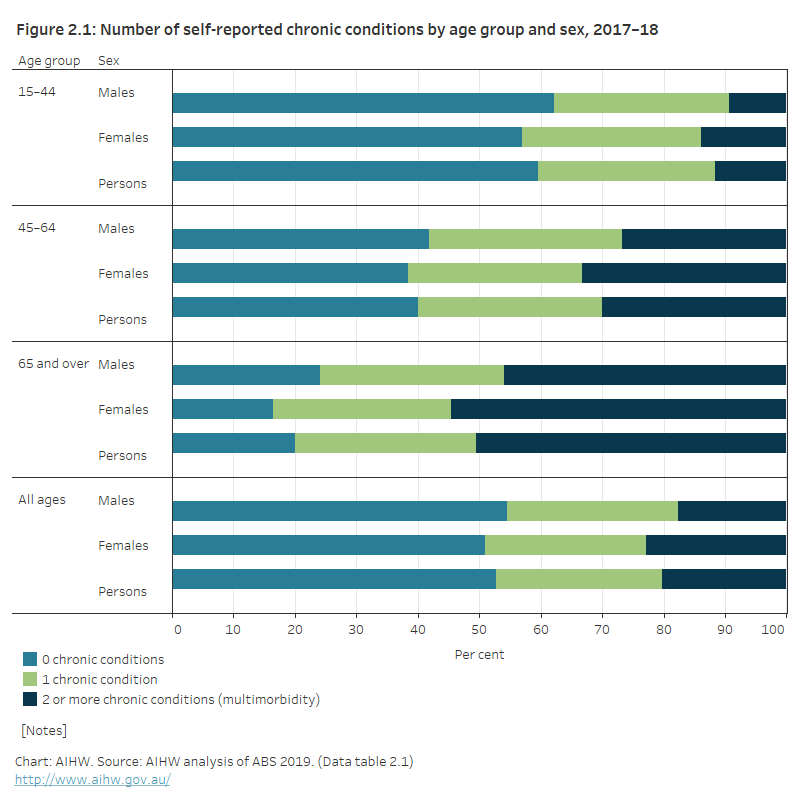What is multimorbidity and how common is it?
Multimorbidity is the presence of 2 or more chronic conditions in a person at the same time. Multimorbidity is a slightly different concept from ‘comorbidity’, which refers to additional conditions (comorbidities) experienced by a person who has a specific condition of interest.
Multimorbidity considers all of the conditions experienced by a person, and places a much greater focus on the person as a whole, rather than their individual conditions (Harrison & Siriwardena 2018). Understanding multimorbidity can be particularly useful in the primary care setting (such as a general practice) where following disease-specific guidelines for the treatment and management of multiple conditions can lead to overprescribing and patient harm (Harrison & Siriwardena 2018).
In this section, multimorbidity estimates are for people of all ages, unless otherwise stated. Where comparisons are influenced by differences in the age structure between groups being compared, age-standardised estimates are provided for comparison. Both crude and age-standardised estimates are provided in the Data tables.
1 in 5 (20%, or 4.9 million) Australians were estimated to have multimorbidity in 2017–18 (ABS 2019).
Multimorbidity becomes more common with age. In 2017–18, multimorbidity affected:
- 1 in 8 (12%) people aged 15–44
- nearly 1 in 3 (30%) people aged 45–64
- 1 in 2 (51%) people aged 65 and over (Figure 2.1; Data table 2.1).
This increase is consistent with a decrease in the prevalence of having no self-reported chronic conditions as people get older. Among those aged 15–44, an estimated 60% had no chronic conditions compared with 40% of people aged 45–64 and 20% of people aged 65 and over. The proportion of people estimated to have only 1 condition was similar across age groups.
Multimorbidity was more common in females of all ages (23%) than males (18%). This difference can be seen across each of the age-specific groups examined, and remained after adjusting for differences in the age structure between males and females.
Figure 2.1: Number of self-reported chronic conditions, by age group and sex, 2017–18
The figure shows the proportion of people with no chronic conditions, 1 chronic condition, or multimorbidity by both sex and age group in 2017-18. Females and older people were more likely to have multimorbidity.

It is important to note that estimates of multimorbidity will differ depending on the definition and source of information used (Dobson et al. 2020; Harrison et al. 2014; Lujic et al. 2017). The number of conditions, the specific conditions included in analysis, and how they are defined will also affect estimates. For example, the chronic conditions selected for analysis may influence prevalence among males and females differently. See Factors to consider when interpreting results in the Technical notes for further detail.
ABS (Australian Bureau of Statistics) 2019. Microdata: National Health Survey, 2017–18, DataLab. ABS cat. no. 4324.0.55.001. Canberra: ABS. Findings based on Detailed Microdata.
Dobson A, Forder P, Hockey R, Egan N, Cavenagh D, Waller M et al. 2020. The impact of multiple chronic conditions: Findings from the Australian Longitudinal Study on Women’s Health. Report prepared for the Australian Government Department of Health, May 2020.
Harrison C, Britt H, Miller G & Henderson J 2014. Examining different measures of multimorbidity, using a large prospective cross-sectional study in Australian general practice. BMJ Open 4: e004694.
Lujic S, Simpson JM, Zwar N, Hosseinzadeh H & Jorm L 2017. Multimorbidity in Australia: Comparing estimates derived using administrative data sources and survey data. PLoS ONE 12(8): e0183817.


